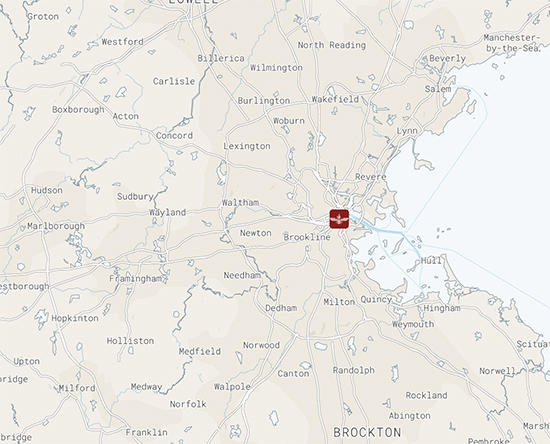Zoroastrianism
Zoroastrianism
Zoroastrianism
Zoroastrianism Timeline
Zoroastrianism in the World (text)
Zoroastrian Legendary History
Pre-Iranian mythology relates the stories of kings and warriors of the legendary Pishdadian Dynasty, predating Zarathustra. According to this history, King Gayomard (Kayomarz) was the first mortal; from his seed grew Mashya and Mashyani, the first human couple. This history also includes the story of King Jamshid, who received a divine warning that the world would be submerged in ice and snow. He built a “Vara” (fortress) and to which he brought pairs of men, women, animals, and seeds.
1,000 - 1750 BCE Zarathustra
Sometime as early as 1750 BCE, the prophet Zarathustra began teaching about the worship of one God, Ahura Mazda. His teachings were remarkable for their monothesitic and dualistic qualities, which scholars believe influenced the development of Judeo-Christian western religious thought. Zarathustra proclaimed a life-affirming message that demanded not so much belief as reason, action, and an ethic of personal responsibility for every individual. He lived a life of reflection and active benevolence.
728-559 BCE Median Empire
Around 728 BCE, Deioces founded the Median Dynasty in the city of Ecbatana. Later during the 7th century BCE, Scythian nomads entered western Iran from the Caucasus. Towards the end of this empire, Cyaxares overthrew the Scythians, and his granddaughter married Nebuchadnezzar II of Babylon.
500-330 BCE Achaemenian Empire
In 500 BCE, Cyrus the Great conquered the Medes, the Lydians and the Babylonians, becoming the first Zarathushti world power and founding the Achaemenian Empire. At the time, this empire was one of the largest empires in history, stretching from modern-day Libya in the West to modern-day Pakistan in the East. During this empire, Darius I the Great (522-486 BCE) expanded the empire into Greece and Macedonia, and was defeated by the Greeks at the Battle of Marathon in 490. Additionally, Xerxes I (486-465 BCE), often known as King Ahasuerus in the Book of Esther, led a land and sea invasion of Greece. The Persians crossed the Hellespont to Athens and took the Acropolis.
331-248 BCE Seleucid Empire
In 331 BCE, Alexander the Great (or Alexander the Accursed) defeated the Achaemenian Empire and took control of Persia. His reign ushered in a period of Hellenization in which Greeks built temples designed to blend Zoroastrian and Greek religious practice.
247 BCE-224 CE Parthian Empire
A religiously heterogenous empire, the Parthians used religion as a diffuse source of influence through individual families to spread Parthian culture.
224-652 CE Sassanian Empire
Throughout the Sassanian Empire, Zoroastrianism gained widespread power and was declared the empire’s official religion as Sassanians built fire temples (Zoroastrain places of worship) across the Middle East. During this time, a master copy of the Avesta, Zoroastrianism’s most important collection of religious texts, is created.
314 CE Armenia Becomes Christian
King Tirdat IV converts to Christianity and by tradition his subjects convert as well. Historical documents suggest that before this conversion, Armenia was likely majority Zoroastrian.
652 CE Fall of Sassanian Empire
After decades of attacks, the Sassanian Empire is absorbed by the Islamic caliphate. From this point forward, Islam becomes the primary religion of Persia, ending centuries of Zoroastrian power.
700s-900s Many Zoroastrians Convert to Islam
During the 8th-10th centuries CE in Persia, Zoroastrians must pay jizya, a tax for non-Muslims. Due to this economic discrimination, Muslim families take hold the majority of land in Persia as Zoroastrian families struggle. Most Zoroastrians convert to Islam, but Zoroastrianism survives despite the pressure.
861 CE Cypress of Kashmar Cut Down
The Abbasid caliph of the Khorāsān region orders that the Cypress of Kashmar, a sacred tree thought to have been planted by Zarathustra, be cut down.
900s CE Zoroastrian Texts Produced
Facing the destruction of fire temples and redaction of sacred texts, Zoroastrian communities launch a concentrated effort to record their ancient stories and practices.
936 CE Migration to India Begins
Facing persecution, Zoroastrians flee from Iran to India, which splits the global Zoroastrian communities into an Iranian group and a community known as Parsis in India. When the first group arrived, the raja (a local ruler) presented them with a full glass of milk, indicating that their land was filled to the brim and unable to accept more people. A dastur (Zoroastrian high priest) responded by pouring sugar into the milk and arguing that Zoroastrians would sweeten the land without overflowing the milk.
934-1055 CE Buyid Dynasty
The Buyids, Shi’i Iranian leaders, take control of Persia. They take an interest in Zoroastrian history and produce coins that feature fire temples. At this point, Zoroastrianism had been displaced and persecuted, but remains resilient.
979 CE Riots in Fārs
Under pressure to convert from the caliph, Zoroastrians in the region of Fārs (modern-day Iran) revolt, showing that Zoroastrianism was still relatively strong in certain areas.
1000s-1500s CE Zoroastrian Dark Ages and Migration to India
During this period of upheaval and changing empires in Iranian history, there are few surviving sources which indicate how Zoroastrian communities fared. However, the great number of Zoroastrians that migrated to Indian during this time indicate that it must have been an organized community effort.
Late 1200s Gujarat Divided into panthaks
Parsis divide Gujarat into five ecclesiastical divisions (panthaks).
1478-1773 Exchanges Between Iranian and Indian Zoroastrians
In a series of letters that begins in 1478, Parsis begin reaching out to Zoroastrian priests in Iran for guidance on rituals and other spiritual matters.
1501-1722 Safavid Empire in Iran
From the outset of the Safavid Empire, the Shah makes financial success difficult for those who do not follow Shi’i Islam. In 1699, a decree forces all Iranians to convert to Shi’i Islam. In the city of Kermān, jurists relocate Zoroastrians to the outskirts of the city to prevent them from mixing with Muslims.
1510–1591 CE Meherji Rana visits Akbar the Great
An important priest from Gujarat, Meherji Rana, pays a visit to Akbar the Great of the Mughal Empire, who loved to learn about different religions and even built a meeting house called Ibādat Khāna (the House of Worship) to meet with spiritual leaders. After talking with Meherji Rana, Akbar then took up an interest in Zoroastrianism and kept a fire burning in his court.
1673 First Fire Temple in Bombay
The first fire temple in Bombay (modern-day Mumbai) is consecrated, indicating that Zoroastrian influence has spread beyond Gujarat.
1789-1925 Qajar Dynasty in Iran
During the Qajar Dynasty, it remained difficult to practice Zoroastrianism in Iran. There were purity laws banning Zoroastrians from participating in public life, and a steady stream of Zoroastrians continued to convert to Islam to gain economic and social freedom.
Late 1700s Parsi Trade in China
What begins as a trading relationship transforms into an immigration relationship as Parsis settle in South China.
Late 1700s - Early 1900s More Migration from Iran to India
As trade between Iranian and Parsi Zoroastrians increases, Iranian Zoroastrians migrate to India in search of prosperity and religious liberty.
Early 1800s Parsis Flourish Economically
Despite the relatively small community of Zoroastrians in Bombay, they own a large number of businesses compared to Hindus and Europeans.
1853 CE Society for the Amelioration of the Conditions of the Zoroastrians in Persia founded
Seeking to assist fellow Zoroastrians in Iran, the Parsis create an aid society.
1857 Bharuch Riot
In the Indian town of Broach (now Bharuch), Zoroastrians are killed and fire temples are burned down after a rumor that a Zoroastrian man had disrespected a mosque.
1861 Zoroastrian Migrants Form First Indian Association in Britain
The first Indian association in Britain, called Religious Funds of Zoroastrians of Europe, is formed to support the growing number of Parsi families migrating to Britain.
1870 Parsis Migrate to Zanzibar
Barghash bin Said, who claimed to be the rightful ruler of Zanzibar, was exiled to Bombay in 1856. When he returned to become Zanzibar’s ruler, he took many Parsis with him, leading to a substantial community of Zoroastrians in Zanzibar.
1947 Partition
During the violence and economic collapses of Partition of India and Pakistan, Parsis begin to migrate to various places around the world.
1970 Freddie Mercury forms Queen
Zoroastrian musician Freddie Mercury, born Farrokh Bulsara, forms the popular rock band Queen.
1970 Australian Zoroastrian Association Forms
In the 1970s, Parsi Zoroastrians begin migrating to Australia and form the Australian Zoroastrian Association in Sydney.
1979 Islamic Revolution
The 1979 Islamic Revolution in Iran limits Zoroastrian rights, leading many to migrate most commonly to North America.
1980 World Zoroastrian Organization Founded
In London in 1980, Zoroastrians come together and form an organization designed to support displaced Zoroastrians in diaspora around the globe.
2003 CE the 3000th Anniversary of Zoroastrian Culture
UNESCO declares 2003 the 3000th Anniversary of Zoroastrian Culture, inspiring celebrations and conferences around the world.
Present
Today there are somewhere between 125,000 and 200,000 Zoroastrians around the world, with most living in India and Iran. There are also substantial communities in the United States, Canada, the United Kingdom, Australia, and Dubai. In addition, some Central Asian countries that formerly belonged to the USSR are beginning to re-examine and celebrate their Zoroastrian heritage.
Zoroastrianism in America (text)
1799 CE Parsis trade with Boston
Because of trade routes between Boston and Bombay, an American merchant noted his trade dealings with Parsis.
1860s CE California Gold Rush Attracts Zoroastrian Immigrants
After moving to California to become a prospector, Maneckji Javeri becomes the first Zoroastrian on record to settle in the United States. There are also records of another Zoroastrian prospector named Cawasji Zaveri.
1865 CE Zoroastrian Writes Abolitionist Letter
The New York Evening Post publishes a letter from a Zoroastrian named Dosabhai Faramji Cama that argues against slavery.
1892 CE Pestonji Davar Immigrates to San Francisco
Another early immigrant to the United States, Pestonji Davar comes to San Francisco from Hong Kong and becomes a millionaire.
1926 CE First Recorded Iranian Zoroastrian Immigrant
Rostam Kermani becomes the first Iranian Zoroastrian immigrant to the United States on record.
1929 CE First Zoroastrian Association Started in Chicago
Zoroastrians start the first Zoroastrian association in the United States, but it disassembles a few years later.
1929 CE First Attempted Zoroastrian Association of New York
After gathering in one member’s living room, seven Zoroastrians create the first Zoroastrian Association of New York. The organization fell apart when its main benefactor died, but a new Zoroastrian association would be founded in New York in 1973.
1960s CE New York Zoroastrians Meet Informally
In this era, there was no official Zoroastrian association, but that did not stop Zoroastrians from cooking holiday meals for each other in rental halls. An Indian restaurant owned by Rustomji Wadia became a popular meeting space.
1973 CE Zoroastrian Association of Greater New York (ZAGNY) Founded
Seeking to formalize their community gatherings, a group of 20 Zoroastrians create the Zoroastrian Association of Greater New York (ZAGNY). Today, the organization supports around 240 households in New York and beyond.
1977 CE First Dar-e-Mehr in the United States Inaugurated
The first Dar-e-Mehr (fire temple) in the United States is inaugurated in New Rochelle, New York.
1983 CE Conversion Initiation Controversy
In New York, a scandal ensues after priests initiate Joseph Peterson, who was not raised Zoroastrian, into the religion with a navjote ritual. Peterson’s initiation sparked arguments between Zoroastrians around the world as they grappled with the validity of conversion (Zoroastrianism is traditionally patrilineal) and the center of authority (some Zoroastrians in India felt that Zoroastrians in the United States were out of touch with tradition).
1986 CE Iranian Zoroastrian Association (IZA) Formed
After a growth in Iranian immigrants to New York, tension rises between the Parsi members of ZAGNY and the Iranian newcomers, causing the Iranian Zoroastrians to branch off into their own group. The IZA and ZAGNY continue to collaborate by co-running the Arbab Rustam Guiv Dar E Mehr Zoroastrian Temple in New York.
1987 CE The Federation of Zoroastrian Associations of North America (FEZANA) Founded
All 16 Zoroastrian associations in Canada and the United States join the multi-national umbrella organization the Federation of Zoroastrian Associations of North America (FEZANA). Today, Fezana has 27 member associations and 12 non-member corresponding organizations.
1988 CE First Zoroastrian Games (Z Games)
At a wedding celebration in 1988, a small group of young Zoroastrians decided to create the Zoroastrian Sports Committee (ZSC) and organize a Zoroastrian sports competition. The tradition continues today as the Zoroastrian Games, or Z Games, hosting athletes from around the world in events like track, basketball, and table tennis.
1993 CE The First World Zoroastrian Youth Congress
FEZANA organizes its inaugural World Zoroastrian Youth Congress, which meets in Los Angeles. The creation of this congress reflects the way that Zoroastrian associations in North America consciously create educational programs and events that center young Zoroastrians.
1998 CE ZAGNY and IZA Joint Celebration
To celebrate Jamshedji Navruz and ZAGNY’s 25th anniversary, ZAGNY and IZA hold a joint celebration with more than 400 guests.
Explore Zoroastrianism in Greater Boston
After evolving separately for centuries in Iran and India, the two streams of the Zoroastrian tradition have come back together in America. In Boston, the community is small but vital: the 150 families affiliated with the Zoroastrian Association of Greater Boston marked their 35th anniversary in 2019. Looking forward, local Zoroastrians hope to develop the Zarathushti Center of Boston as a dedicated place for worship, gathering, and education.
 Zoroastrianism is a monotheistic religion based upon the teachings of the ancient Persian prophet Zarathushtra. The Gathas, hymns considered the most important Zoroastrian teachings, describe an ethical path for living in a world conflicted between good and evil. The path calls for humans to live a life of good thoughts, good words, and good deeds....
Zoroastrianism is a monotheistic religion based upon the teachings of the ancient Persian prophet Zarathushtra. The Gathas, hymns considered the most important Zoroastrian teachings, describe an ethical path for living in a world conflicted between good and evil. The path calls for humans to live a life of good thoughts, good words, and good deeds.... 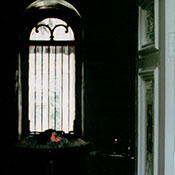 Zoroastrians gained acceptance and eventual imperial power in Central Asia, reaching their zenith when Zoroastrianism was established as the state religion of the Sassanian Empire in the 3rd century. When the Sassanian Empire fell in 652 CE to Arab Muslims, Zoroastrians were forced to flee, convert, or practice in secret. A group of Zoroastrians, known as Parsis, fled to Gujurat, where they developed a cultural identity distinct from Iranian Zoroastrians....
Zoroastrians gained acceptance and eventual imperial power in Central Asia, reaching their zenith when Zoroastrianism was established as the state religion of the Sassanian Empire in the 3rd century. When the Sassanian Empire fell in 652 CE to Arab Muslims, Zoroastrians were forced to flee, convert, or practice in secret. A group of Zoroastrians, known as Parsis, fled to Gujurat, where they developed a cultural identity distinct from Iranian Zoroastrians.... 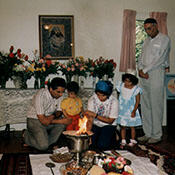 In the United States, Parsi and Iranian Zoroastrian communities sometimes hold separate schedules and services, but many share places of worship and are members of the same national Zoroastrian organizations. On the national and trans-national level, seminars, youth programs, and federations bring these two communities together. These interactions contribute to distinct modes of American Zoroastrian identities and communities....
In the United States, Parsi and Iranian Zoroastrian communities sometimes hold separate schedules and services, but many share places of worship and are members of the same national Zoroastrian organizations. On the national and trans-national level, seminars, youth programs, and federations bring these two communities together. These interactions contribute to distinct modes of American Zoroastrian identities and communities.... 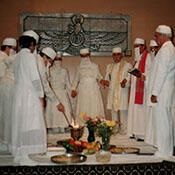 Zoroastrian houses of worship are called dar-e-mehrs, or fire temples. Their primary purpose is to house the “eternal flame,” a fire with which many Zoroastrian rituals are performed. While Indian dar-e-mehrs are closed to non-Zoroastrians, dar-e-mehrs in the United States act both as places of worship and learning centers open to non-Zoroastrians....
Zoroastrian houses of worship are called dar-e-mehrs, or fire temples. Their primary purpose is to house the “eternal flame,” a fire with which many Zoroastrian rituals are performed. While Indian dar-e-mehrs are closed to non-Zoroastrians, dar-e-mehrs in the United States act both as places of worship and learning centers open to non-Zoroastrians.... 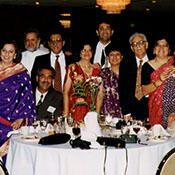 The Zoroastrian initiation ceremony, called the Navjote by Parsi Zoroastrians or Sudreh-Pushi by Iranian Zoroastrians, involves the investiture of a sacred shirt (sudreh) and sacred cord (kushti) that will be worn throughout life as a reminder of how to live ethically. Children choose to be initiated, typically between ages 7 and 15, and the initiation rites are the same across genders....
The Zoroastrian initiation ceremony, called the Navjote by Parsi Zoroastrians or Sudreh-Pushi by Iranian Zoroastrians, involves the investiture of a sacred shirt (sudreh) and sacred cord (kushti) that will be worn throughout life as a reminder of how to live ethically. Children choose to be initiated, typically between ages 7 and 15, and the initiation rites are the same across genders.... 